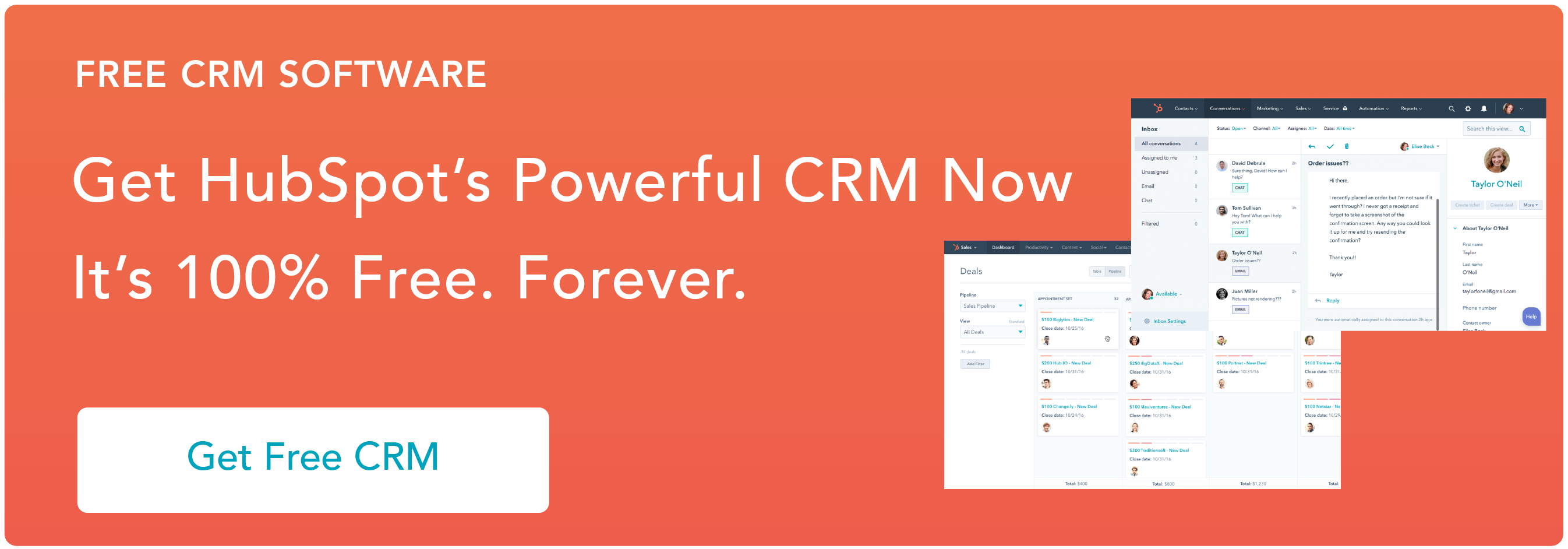By integrating your CRM into each step of the sales process, you can expedite the buyer journey from lead to customer. CRM processes are actions aligned with the sales process to help you build stronger relationships with your customers faster, helping you close more deals, keeping your customers coming back for more.
Let’s review the common CRM processes you and your team need to know to work more efficiently and land more sales.
CRM Processes
1. Capturing Leads
First and foremost, your CRM should be a repository for capturing leads across all channels. Whether your organization collects leads through website traffic, freemium sign-ups, or referrals from previous customers, using your CRM (instead of a complicated spreadsheet) to capture basic information about your leads sets you up for more efficient workflows throughout the sales process.
Once you've leveraged your CRM to capture your leads, it's important to document their contact information.
2. Creating and Maintaining Contact Records
As you continue through the prospecting process, you can use your CRM to create and maintain contact records to house the information you learn about your leads.
For example, if you work for a company that sells innovative HVAC (heating, ventilation, and air conditioning) products and a new lead gets saved as a contact in your CRM because they opted in for a free guide on your website called “Five Signs It’s Time to Replace Your AC Unit,” your CRM can log their contact record as someone who may be interested in new air conditioning equipment as opposed to being interested in a new heating system.
 Once you have those records in place, make use of them through personal outreach.
Once you have those records in place, make use of them through personal outreach.
3. Connecting with Leads.
Once you have a contact record saved with basic information about your lead — with details such as their name, email address, geographic location, and potential product they are interested in — you can then use your CRM to contact them and learn more about their situation.
Ideally, your CRM should integrate directly with your email and call system, so whether you are corresponding by email or hop on the phone you should be able to log your correspondence with the lead directly into your CRM.
 After touching base with those leads, you need to pin down the feasibility of winning their business.
After touching base with those leads, you need to pin down the feasibility of winning their business.
4. Qualifying Leads
When initially connecting with your leads, your goal is to determine if they are sales qualified. Essentially, you want to make sure they are a good fit for your product or service at this time.
As you go through the lead qualification stage, you want to compare the lead’s needs and information to your ideal customer profile. A helpful way to determine if a lead is sales qualified is to ask them open-ended questions, allowing them to provide more context about their situation. Here are some sales qualifying questions you can consider:
- What problem are you looking to fix?
- Have you tried to solve the problem previously? What has or hasn’t worked?
- Do you have a budget allocated for this?
- How does the decision-making process work for implementing these kinds of solutions?
- What other offerings are you considering?
Although there is no clear "yes" or "no" involved with any of these questions, the answers can help you determine if the lead is ready to be sold to. If you believe the lead is qualified, you can log this information in their contact record and move them to the next stage in the sales process in your CRM.
5. Documenting Objections
As you move through the sales process, you will naturally hear objections as you try to make the sale. If a contact provides pushback during your pitch or raises a flag about your product the rest of your team should be aware of, your CRM is the ideal place to document these objections.
Doing so in your CRM gives your team access to information that can provide valuable training or shape updated strategies. Additionally, if your lead gets passed to another rep, having their reservations or objections documented in your CRM helps your colleague know where you left off and creates a smooth transition, which creates a better experience for the rep and the customer.
6. Issuing Proposals
Proposal software can be a helpful tool. As you share proposals, you can integrate your proposal software with your CRM to quickly create and share proposal documents directly through your CRM.
Using your CRM to issue and track proposals can give you insight into whether your document has been viewed or opened, and allows you to link your prospect’s contact records to specific deals all within your CRM.
7. Logging Deals
When your customer accepts your proposal and the deal has been closed, you can log the deal in your CRM for accurate reporting. This will provide valuable information for reporting and forecasting purposes.
If the deal was closed-lost, you’ll want to make sure you log that as well. Tracking deals that didn’t result in a sale can provide context if that lead moves through the sales process for a different offering, or if the initial conversation reopens with them at a later date.
A solid CRM process doesn't end here. Even after closing a deal with a prospect, there's still room for more business.
8. Upselling/Cross-Selling
Last but certainly not least, you can use your CRM to assist with an upsell or cross-sell after landing a deal. Because you should have all of your communications with your customer tracked in their CRM record and you have built a relationship with them, you can offer additional products or services that can complement their initial purchase or provide a solution to another problem they are looking to solve.
Proper use of your CRM can improve efficiency for you and your sales team during each step of the sales process. To take your processes to the next level, check out these must-have CRM integrations to automate your entire business.

.jpg)






.jpg)
![The Importance of a CRM: Why Your Company Needs a CRM to Grow Better [New Data]](https://53.fs1.hubspotusercontent-na1.net/hubfs/53/1-Feb-23-2021-12-59-16-65-AM.jpg)




![How to Build a Business Case for CRM [Infographic]](https://53.fs1.hubspotusercontent-na1.net/hub/53/file-2635220133.jpg)